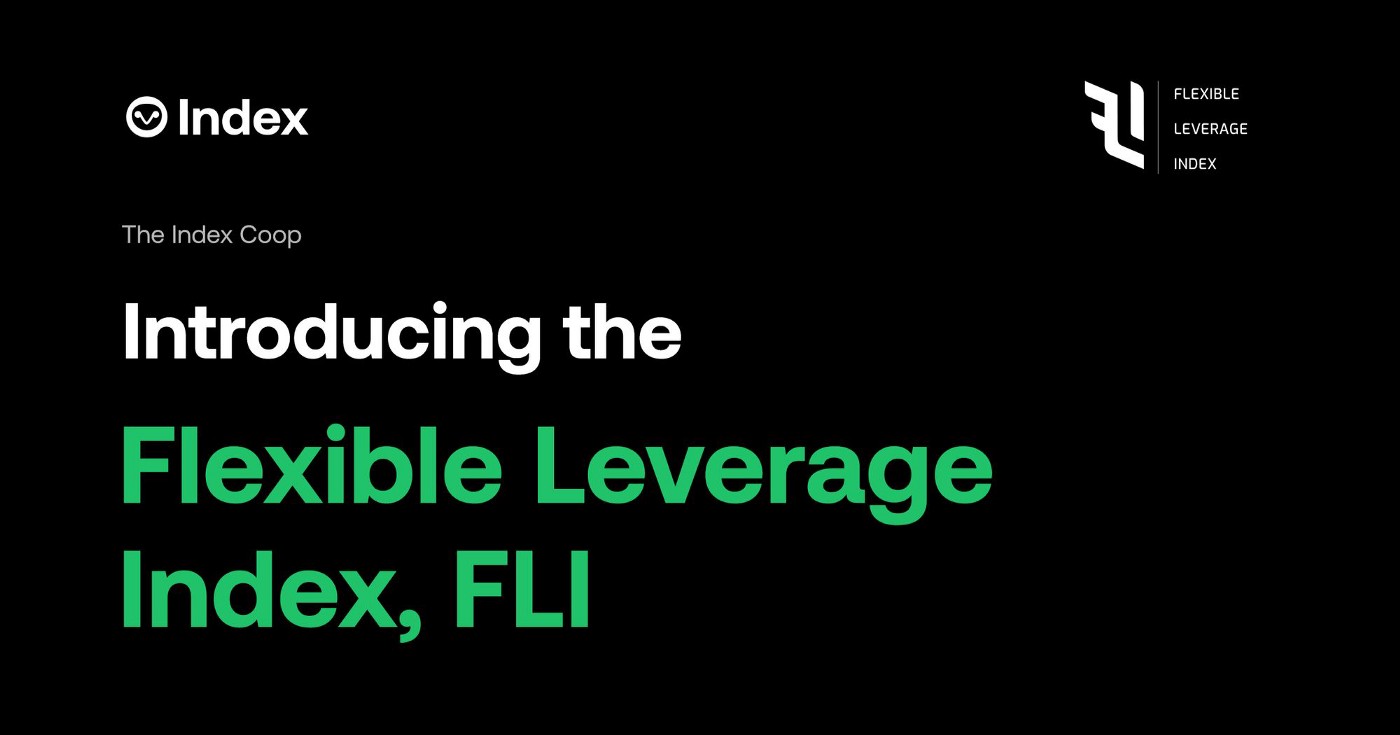All blogposts
Introducing the Flexible Leverage Index (FLI), by Pulse Inc.
Introducing the Flexible Leverage Index (FLI), by Pulse Inc.
FLI is the first fully-collateralized leverage token which is redeemable into its components (ETH, USDC). Collateralization allows for a better risk profile.
3/15/2021
Index Coop

FLI, Pronounced “Fly”
Flexible Leverage Index (FLI) are structured ERC-20 products that enable traders to automate a target leveraged exposure in a decentralized manner.
The FLI series is the second collaboration with the team at DeFi Pulse (Pulse, Inc.)—designed to minimize the risks and costs typically associated with maintaining collateralized debt. Today, a flagship ETH2x version is available on TokenSets (for non-U.S. users) with an initial supply cap of 50,000 units.
Leverage is one of DeFi’s killer use-cases. However, traditional DeFi leverage workflows are not for the faint of heart—users must monitor health ratios, manage liquidation risk, and avoid penalties. FLI was created to make leverage safer and simpler to maintain.
Four Major Benefits of FLI Products
The Flexible Leverage Index uses a novel strategy built on Set Protocol and Compound, abstracting collateralized debt management into a simple ERC-20 index token. While initially launched for ETH, FLI can be adapted for other assets on lending protocols, such as wBTC, YFI, and LINK.
Benefits include:
Decreased (but not eliminated) risk
Lower gas and fee burden
Ease of use
Composability with other DeFi protocols
1. Decreased Risk
Leverage is inherently risky. FLI mitigates some of that risk by automatically maintaining target ratios and flexibly rebalancing over time. This helps ensure collateral levels stay above liquidation thresholds—even during major volatility spikes. FLI also includes an emergency deleveraging mechanism for black swan events.
Additionally, FLI is the first fully collateralized leverage token that is redeemable into its components (e.g., ETH, USDC), offering a stronger risk profile than synthetic leverage products.
2. Lower Fee Burden
FLI reduces your fee burden through a unique rebalancing algorithm that improves efficiency significantly. The token carries a 1.95% annualized streaming fee—much lower than comparable centralized exchange products—and has no slippage due to its composable nature.
3. Ease of Use
The Flexible Leverage Index is extremely easy to use: simply buy and sell it on TokenSets or Uniswap. Rebalancing happens automatically, eliminating the need to constantly monitor your position for liquidation risk.
4. Composability
Because FLI is a fully collateralized ERC-20 Set token, it can be integrated into a wide variety of DeFi services. This composability opens the door to broader use cases and more flexible strategies.
FLI Methodology 101: What’s Under the Hood?
Index Coop products follow strict methodologies. You can dive deeper via DeFi Pulse’s introduction to FLI and TokenSets’ technical documentation.
Initial parameters for ETH2x FLI:
Underlying Asset: ETH
Target Leverage Ratio: 2x
DeFi Lending Protocol: Compound
Max Leverage Ratio: 2.3x
Min Leverage Ratio: 1.7x
Recentering Speed: 5%
Fees
Streaming fee: 1.95% annualized
Mint/Redeem fee: 0.1%
Revenue split: 60% Index Coop / 40% DeFi Pulse
Glossary
Borrow Rate: Cost to borrow from the lending protocol over the last epoch
Epoch Length: Time between rebalances
TLR (Target Leverage Ratio): Long-term leverage target (assets / debt)
CLR (Current Leverage Ratio): Actual current leverage ratio
MAXLR: Max allowed leverage ratio after rebalance
MINLR: Min allowed leverage ratio after rebalance
RS (Recentering Speed): Rate at which CLR moves back to TLR over time
Dive deeper
Watch, read, and learn everything you need to master our leverage tokens.
Subscribe to our newsletter
Join over 6,000 subscribers in receiving weekly updates about our products, DeFi, and the onchain structured products space.
FAQs
Streaming fees (an annual fee paid continuously block-by-block)
Mint and redeem fees
Borrow costs (interest paid to borrow funds from onchain markets when using leverage)
Index Coop yield tokens simplify earning yield in DeFi by automating complex strategies and diversifying across protocols. They are user-friendly and cost-efficient, appealing to both new and seasoned DeFi users.
Leverage tokens automate a leveraged position by utilizing onchain money markets like Aave or Morpho to borrow funds, amplifying a user's exposure to an asset without requiring manual management. The token's smart contracts autonomously handle the borrowing, lending, and rebalancing of assets, maintaining a consistent leverage ratio despite market fluctuations. This automation eliminates the complexities of collateral management and liquidation risks, while also charging low, transparent fees that avoid expensive funding rates often charged by perps.
Index Coop is a decentralized autonomous organization (DAO) that specializes in creating and maintaining onchain structured products. Index Coop aims to democratize access to the crypto market, empowering everyone to participate in the growing digital asset ecosystem with ease.
No, yield automatically compounds and accrues to the token price. The value of the tokens you hold in your wallet will simply go up over time without the need to claim or compound rewards.
Index Coop products protect you from liquidation with automated risk management that rebalances assets to maintain a target leverage ratio that avoids liquidation.
INDEX is the ERC-20 governance token on Ethereum for Index Coop. INDEX empowers its holders to participate in decision-making processes that shape the future of Index Coop.
Yes, all Index Coop products are instantly redeemable for their underlying value at all times.
Yes, all Index Coop smart contracts have been audited by leading independent security firms such as OpenZeppelin, ABDK, Isosiro, & more. There is also an active bug bounty program through ImmuneFi. Audit information is published in the docs here.
Costs and fees vary by product, but typically most products can include some combination of the following: